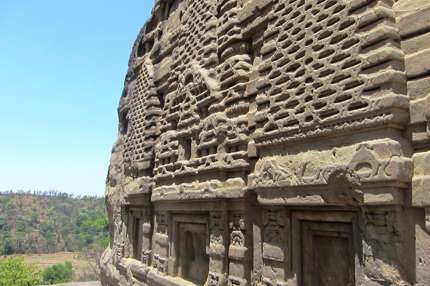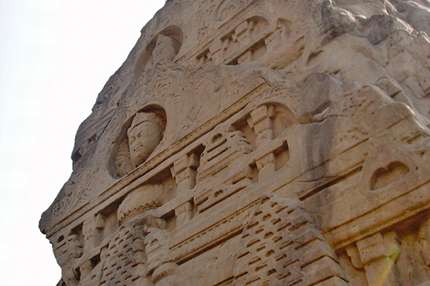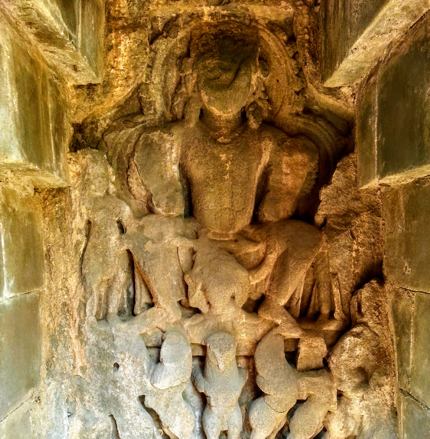There’s a certain dishevelled majesty to the crumbling shikharas (towers) and unfinished carvings at Masroor temple, in rural Kangra
The town of Kangra may not instantly ring a bell to most people, but if we were to mention that it lies just 28km (17 miles) south of McLeod Ganj, Dharamshala, where the Dalai Lama established his government-in-exile, then you probably could imagine a land where verdant foothills give way to the blue buttress of the Dhauladhar mountain chain in the distant.
The mountains here are mighty, standing tall as if they are guarding the Himalayas from some unimaginable mythical foe, or perhaps a spiritual one.
Contrary to McLeod Ganj which is replete with throngs of spiritual questers, Kangra is a quiet agricultural town where most families work in the fields of wheat, corn, rice and tea. Few tourists venture to this part of India, and for the intrepid tourists who are willing to travel further 36km (22 miles) west of Kangra on the Nagrota Suriyan link road, you will soon chance upon Masroor temple, a magnificent temple that is often overlooked by tourists.
Masroor temple, an uncut diamond
Popularly known as the Himalayan Pyramid, Masroor (also spelt Masrur) is one of a small number of rock-cut temples in all of India.
Strictly speaking, Masroor is a cluster of 15 rocks temples carved out of a single rock and built around a central shrine. In other words, the 14 surrounding shrines were cut from the outside but the central shrine was cut from the inside – they really are a marvel of construction.
The central shrine houses idols of Lord Rama, Lord Lakshmana and Goddess Sita, all facing east. There is also a figure of Lord Shiva over the doorway to the main altar at Masroor. Cut deep into the rock, the depiction of the coronation of Shiva upon the lintel was one of the best-preserved of the temple’s ravaged carvings. It was a delight to behold; Shiva’s posture here was with his eyes closed, sat very much like the Buddha is known to sit. The presence of this figure has led scholars and archaeologists to believe that the temple was originally dedicated to Lord Shiva, but was later converted to worship Lord Rama.
Said to be built around the 8th and 9th centuries, Masroor shares a stark resemblance with the temples at Angkor Wat in Cambodia which was built in the first half of the 12th century.
The legend
Ancient buildings are often tied to colourful legends and Masroor is no exception. It is said that the Pandavas, the five acknowledged sons of Pandu in the Mahabharata (one of the two major Sanskrit epics of ancient India) were once living here and building the temple during their exile. Unfortunately, they were being recognised and had to abandon the place quickly, hence the temple complex was left unfinished.
The history
Archaeologists believe that Masroor temple was still being sculpted when Mahmud of Ghazni laid siege to the region in 1009.
Known as the ‘conqueror of a thousand temples’, Mahmud plundered the fabled wealth of the Kangra valley, Masroor and all. He destroyed as he went, but Masroor’s saving grace was its construction from bare rock, rendering it virtually indomitable by Mahmud’s army.
Although Mahmud did not destroy the temple, it is believed that his untimely arrival prevented the temple’s completion.
Subsequently, natural forces were to leave Masroor destitute at the turn of the 20th century, when in 1905, a strong earthquake devastated the region, toppling Masroor’s stone pillars and ruining the northernmost shikhara.
A narrow stairway, the steps a little worn through centuries of use, cut up through the rock onto the roof of the temple, atop which stood the remaining shikharas. The central tower remains intact, but the other nine were not quite so lucky. Some had lost half of their glory; others had been repurposed by gravity as a rockery of sorts by the pond nearby.
Before you go
The Masroor rock-cut temple is open seven days a week, entry is a few rupees. The temple stands roughly:
- 496km (308 miles) north of the Indian capital, Delhi
- 50km (31 miles) south of McLeod Ganj
- 36km (22 miles) west of Kangra, the nearest town
Getting there
In theory, you can take a bus from Kangra to Gaggle, then switch to another bus for Masroor. The journey takes about 2 hours. But as local transport can be unpredictable in the Himachal Pradesh region; the best way to reach Masroor is by hiring a car and driver from Kangra, or outside Dharamshala bus station or near the main square of McLeod Ganj. You are advised to negotiate with the driver first.
Dharamshala Gaggal Airport, near Kangra, operates daily services to Delhi.
Two important days
Masroor temple is a protected monument. While anyone can visit by paying an entrance fee, the locals are also allowed to offer prayers on two major occasions – Rama Navami (a spring Hindu festival that celebrates the birthday of Lord Rama) and Janmashtami (which celebrates the birthday of Krishna).
The article was first published in 2017 and updated in 2020.
If you found this interesting, you might also enjoy:








